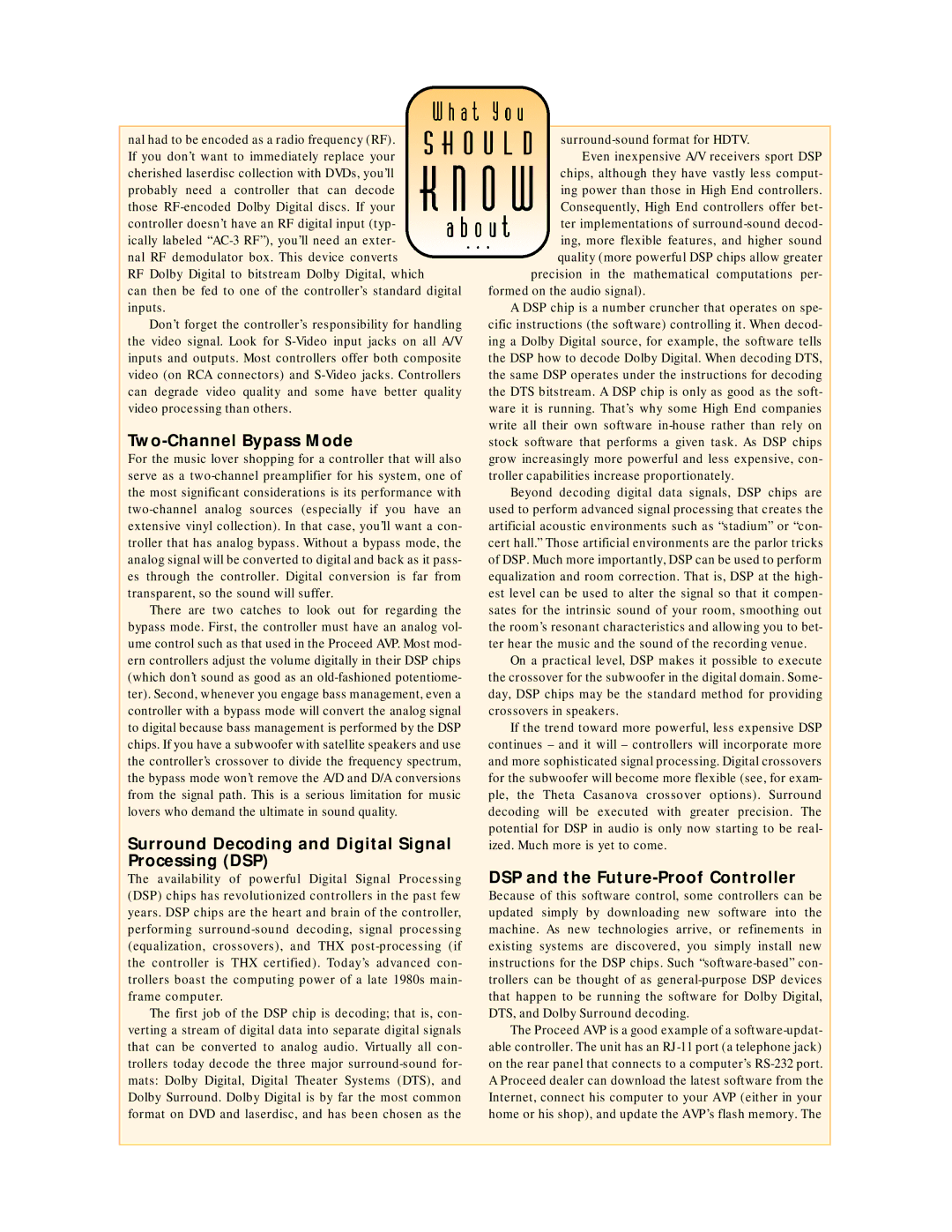
nal had to be encoded as a radio frequency (RF).
If you don’t want to immediately replace your
cherished laserdisc collection with DVDs, you’ll
probably need a controller that can decode
those
controller doesn’t have an RF digital input (typ-
ically labeled
nal RF demodulator box. This device converts
RF Dolby Digital to bitstream Dolby Digital, which
can then be fed to one of the controller’s standard digital
inputs.
Don’t forget the controller’s responsibility for handling
the video signal. Look for
inputs and outputs. Most controllers offer both composite
video (on RCA connectors) and
can degrade video quality and some have better quality
video processing than others.
Two-Channel Bypass Mode
For the music lover shopping for a controller that will also
serve as a
the most significant considerations is its performance with
two-channel analog sources (especially if you have an
extensive vinyl collection). In that case, you’ll want a con-
troller that has analog bypass. Without a bypass mode, the
analog signal will be converted to digital and back as it pass-
es through the controller. Digital conversion is far from
transparent, so the sound will suffer.
There are two catches to look out for regarding the
bypass mode. First, the controller must have an analog vol-
ume control such as that used in the Proceed AVP. Most mod-
ern controllers adjust the volume digitally in their DSP chips
(which don’t sound as good as an
ter). Second, whenever you engage bass management, even a
controller with a bypass mode will convert the analog signal
to digital because bass management is performed by the DSP
chips. If you have a subwoofer with satellite speakers and use
the controller’s crossover to divide the frequency spectrum,
the bypass mode won’t remove the A/D and D/A conversions
from the signal path. This is a serious limitation for music
lovers who demand the ultimate in sound quality.
Surround Decoding and Digital Signal
Processing (DSP)
The availability of powerful Digital Signal Processing
(DSP) chips has revolutionized controllers in the past few
years. DSP chips are the heart and brain of the controller,
performing
(equalization, crossovers), and THX
the controller is THX certified). Today’s advanced con-
trollers boast the computing power of a late 1980s main-
frame computer.
The first job of the DSP chip is decoding; that is, con-
verting a stream of digital data into separate digital signals
that can be converted to analog audio. Virtually all con-
trollers today decode the three major
mats: Dolby Digital, Digital Theater Systems (DTS), and
Dolby Surround. Dolby Digital is by far the most common
format on DVD and laserdisc, and has been chosen as the
Even inexpensive A/V receivers sport DSP
chips, although they have vastly less comput-
ing power than those in High End controllers.
Consequently, High End controllers offer bet-
ter implementations of
ing, more flexible features, and higher sound
quality (more powerful DSP chips allow greater
precision in the mathematical computations per-
formed on the audio signal).
A DSP chip is a number cruncher that operates on spe-
cific instructions (the software) controlling it. When decod-
ing a Dolby Digital source, for example, the software tells
the DSP how to decode Dolby Digital. When decoding DTS,
the same DSP operates under the instructions for decoding
the DTS bitstream. A DSP chip is only as good as the soft-
ware it is running. That’s why some High End companies
write all their own software
stock software that performs a given task. As DSP chips
grow increasingly more powerful and less expensive, con-
troller capabilities increase proportionately.
Beyond decoding digital data signals, DSP chips are
used to perform advanced signal processing that creates the
artificial acoustic environments such as “stadium” or “con-
cert hall.” Those artificial environments are the parlor tricks
of DSP. Much more importantly, DSP can be used to perform
equalization and room correction. That is, DSP at the high-
est level can be used to alter the signal so that it compen-
sates for the intrinsic sound of your room, smoothing out
the room’s resonant characteristics and allowing you to bet-
ter hear the music and the sound of the recording venue.
On a practical level, DSP makes it possible to execute
the crossover for the subwoofer in the digital domain. Some-
day, DSP chips may be the standard method for providing
crossovers in speakers.
If the trend toward more powerful, less expensive DSP
continues – and it will – controllers will incorporate more
and more sophisticated signal processing. Digital crossovers
for the subwoofer will become more flexible (see, for exam-
ple, the Theta Casanova crossover options). Surround
decoding will be executed with greater precision. The
potential for DSP in audio is only now starting to be real-
ized. Much more is yet to come.
DSP and the Future-Proof Controller
Because of this software control, some controllers can be
updated simply by downloading new software into the
machine. As new technologies arrive, or refinements in
existing systems are discovered, you simply install new
instructions for the DSP chips. Such
trollers can be thought of as
that happen to be running the software for Dolby Digital,
DTS, and Dolby Surround decoding.
The Proceed AVP is a good example of a
able controller. The unit has an
on the rear panel that connects to a computer’s
A Proceed dealer can download the latest software from the
Internet, connect his computer to your AVP (either in your
home or his shop), and update the AVP’s flash memory. The
